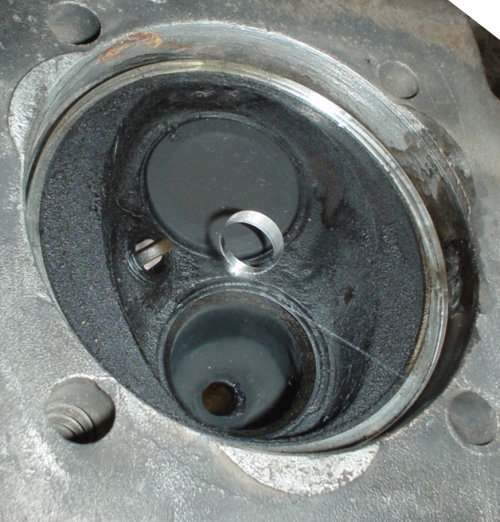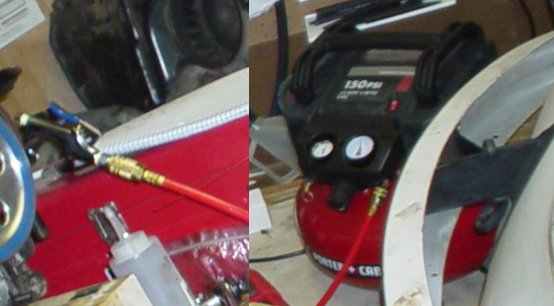[WARNING: Long explanatory post. For those of you who already know about compression ratios: I think the reason my #1 valve was having problems was the CR on that cylinder was 8.2. A known good cylinder was 7.6. Spec for the engine is 7.3.]
In discussions of fire and fire prevention, it's common to talk about the required ingredients for starting fire: air, fuel, and an ignition source. Remove at least one, and you won't have a fire.
An four-stroke, internal-combustion engine (most car engines) is a little more complicated than that. I've heard people use the same three ingredients to talk about what can fail and make a car not run right, and that's useful, but it's an oversimplification if you want to understand what's going on inside the car.
The equivalent list for an internal-combustion engine are: - air intake - mix fuel with air (carburetion system) - compress the mixture - ignition to ignite the mixture - a place for the exhaust to go
All of these items must be present for the engine to run at all. However necessary, the following relationships are also required to be somewhat correct for the engine to run: - amount of fuel per air (called the "mixture") - when the ignition spark happens in time compared to the peak of compression (called "timing" or sometimes "spark advance") - amount of compression (called "compression ratio")
Further complicating matters, if any of the parameters changes rapidly, then there must be a mechanism to re-adjust the other parameters to keep the engine running. If this doensn't happen, then engine can stop.
When people think about running and adjusting engines, the mixture and the timing both at constant engine speed and as the engine changes speed are very important. If the mixture or the timing get far enough off, the engine quits and you know it. In the engine in my Beetle, the carburetor controlls the mixture and it has various mechanisms to set the mixture correctly and different engine speeds and loads. There is a vacuum port in the carburetor that's connected to the distributor; the distributor uses a combination of this vacuum signal and the engine rpm to set the spark timing.
I've spent a lot of time getting the distributor and the carburetor right in my engine. It's easy to tell when they're not working right; the car dies as I try to pull away from a stop sign or stumbles when I push on the gas or makes funny noises when I take my foot off the gas. When you get those adjustments wrong, it's easy to tell, because the car does something that you notice.
HOWEVER--there's a third adjustment in the above list. COMPRESSION RATIO (abbreviated CR). CR is the ratio of the inital to final volume of the fuel-air charge just before its ignited. It's a very important parameter for the running of the engine. The higher the CR, the more mechanical energy can be extracted from the fuel and so the more efficiently the engine will run. However, higher CR also means the engine will run HOTTER, which is very important in an air-cooled engine like mine.
It's easy to overlook CR because it's not something you can adjust from outside the engine, it's a function of the geometry of the insides of the cylinders. However, it's very important that it be set to a known, correct value for the engine to run correctly. Since CR is a function of the geometry of the cylinder/piston/head combination, it's physically possible that it's DIFFERENT for different cylinders (although that's almost certainly not what you want).
Compression ratio is measured by measuring the volume of the combustion chamber and the volume that the piston displaces in its motion, and plugging those into the compression ratio formula. The shape of the combustion chamber is very complicated, so it's measured with a liquid after using disk to form a top to the chamber with a small hole in the middle:

(This chamber isn't ready for volume measurement, obviously; one of the valves isn't installed. This is to illustrate how the plate fits over the chamber.)
I used water for the fluid, which isn't ideal, but it's readily available and easy to replace. Once I dry the chamber out with paper towels, here's my final drying method:

I measured the chamber volume of cylinder #1, which is the one that had been having problems, and cylinders #3 and #4, which had always been working right. One thing I discovered that the head on the right side of the engine had been machined so much that it had a ridge around the inside of the chamber:

that sticks up higher than the sealing surface (the shiny bit to the left of the ridge). My measurement of the volume of the combustion chamber for cylinder 1 was significantly different than for that of 3 and 4.
My best measurement for the CR of cylinder #4 is 7.6. My measurement for #1 is 8.2! By the way, the specification for the engine was 7.5 earlier in the 1600 engine, and 7.3 for the year of my engine.
So cylinder #1 has a CR of 8.2 instead of 7.3 (which means running hotter) and I also had air leaking into that side of the engine (means running leaner and thus hotter). I believe those two factors in combination are the cause of the stretching exhaust valve that has been my long-term problem with my car.
What to do about it? News at 11. :-D